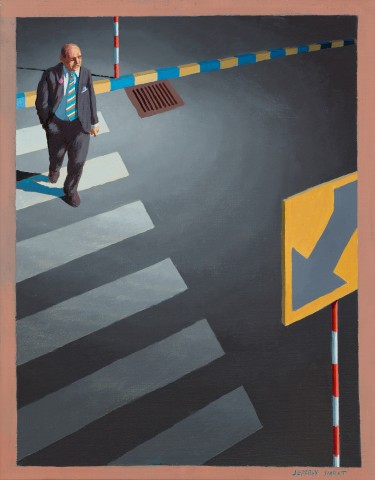STUDY FOR MAN WITH BOUQUET, 1981
JEFFREY SMART
oil on canvas on board
45.0 x 35.0 cm
signed lower right: JEFFREY SMART
Rex Irwin Art Dealer, Sydney
Private collection
Christie’s, Melbourne, 23 November 1999, lot 14
Joseph Brown Gallery, Melbourne
The Cbus Collection of Australian Art, Melbourne, acquired from the above on 25 November 1999
Jeffrey Smart – Recent Paintings, Redfern Gallery, London, 11 November – 4 December 1982, cat. 24
Jeffrey Smart, Rex Irwin Art Dealer, Sydney, 5 – 16 April 1983, cat. 3
Morning, Noon and Night, Latrobe Regional Gallery, Victoria, 13 July – 13 October 2019
Jeffrey Smart, National Gallery of Australia, Canberra, 11 December 2021 – 15 May 2022 (label attached verso)
on long term loan to Wollongong City Gallery, New South Wales
Quartermaine, P., Jeffrey Smart, Gryphon Books, Melbourne, 1983, cat. 783, p. 117
McDonald, J., Jeffrey Smart / Paintings of the '70s and '80s, Craftsman House, Sydney, 1990, cat. 243, p. 160
Nainby, B., Stanhope, Z., and Furlonger, K., The Cbus Collection of Australian Art, in association with Latrobe Regional Gallery, Melbourne, 2009, pp. 17, 128 (illus.), 232
Hart, D., and Edwards, R., Jeffrey Smart, National Gallery of Australia, Canberra, 2021, p. 163
Man with Bouquet, 1982, synthetic polymer paint and oil on canvas, 90.0 x 75.0 cm, private collection
Man with Bouquet was also produced into an aquatint (edition 100) in 1983 to accompany the deluxe edition of Quartermaine, P., Jeffrey Smart, Gryphon Books, Melbourne, 1983. In 1997 a further black and white etching of this subject was also produced.
We are grateful to Stephen Rogers, Archivist for the Estate of Jeffrey Smart, for his assistance with this catalogue entry.
Jeffrey Smart’s aim was to create ‘a memorable image; one that not only strikes the viewer but also surprises and puzzles’.1 His paintings amalgamated, in the manner reminiscent of magical realism, a combination of classical geometric composition, visual suspense and uncanny subject matter. In Study for Man with Bouquet, 1981 a besuited balding gentleman nonchalantly crosses a road at a zebra crossing, with a hand in his pocket he stares blankly into the void. Curiously, in this study, he does not hold the eponymous bouquet in a closed fist, as he does in both the final version of this painting (yellow blooms in pink wrapping) and in coloured aquatints of the same title (pink blooms in yellow wrapping).
In the late 1970s, Smart moved into a large farmhouse in Tuscany with a committed life partner Ermes de Zan but continued living a peripatetic life. His paintings from this time began to reflect an underlying concern with the wonders and possibilities of travel. Often showing empty areas of transit such as bus stops, motorways, and footpaths, they featured raking vantage points, flattened planes, and strong contrasts of light and shade. In Study for Man with Bouquet, the businessman, although well-dressed in a vertically pin-striped suit, with a tie, pocket square and a pink carnation in his buttonhole, is completely anonymous. He wanders safely, but beyond the limitless expanse of painted bitumen, there is no indication of location or time of day.
Smart’s archetypal motif of the striped traffic marking is emphatically repeated on various items in this painting: poles, asphalt and kerbsides, drawing the attention not of motorists but of the viewer of this painting. A strong pool of light from a streetlamp existing beyond the frame, spills on to the figure in a concentrated ring, the focal point where Smart’s competing striations converge. Jeffrey Smart explained ‘[my paintings are] always about the light, obviously it must be the light. Without the light, you don’t see anything […] by casting shadows and making stapes that never existed before, or the mistiness of making mystery’.2
1. Malouf, D., ‘David Malouf remembers Jeffrey Smart - and Smart-talk from a Tuscan studio’, Australian Financial Review, Sydney, 14 May 2016
2. De Groen, G., ‘Where the light must rule’, Art and Australia, Fine Arts Press, Sydney, vol. 19, no. 2, Summer 1981, p. 190
LUCIE REEVES-SMITH
